INTRODUCTION TO THE PROFESSION Lecture 1. Introduction Contents
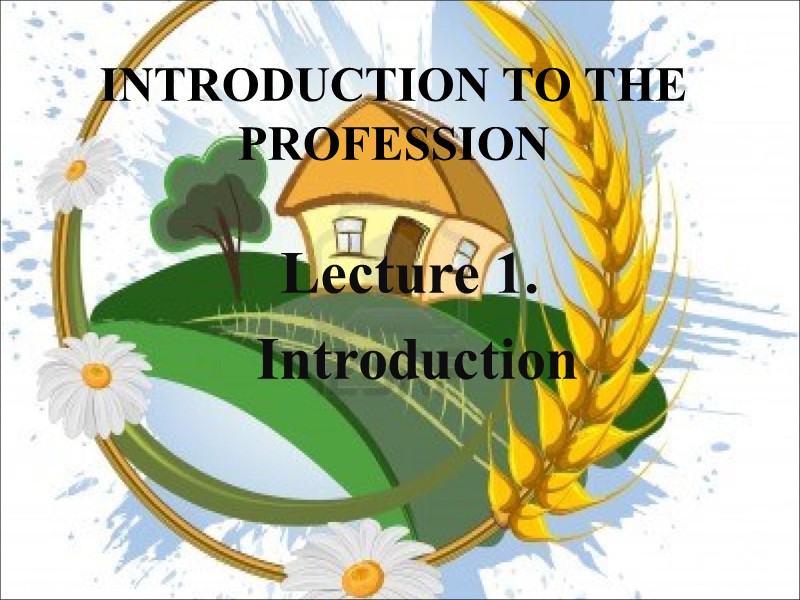
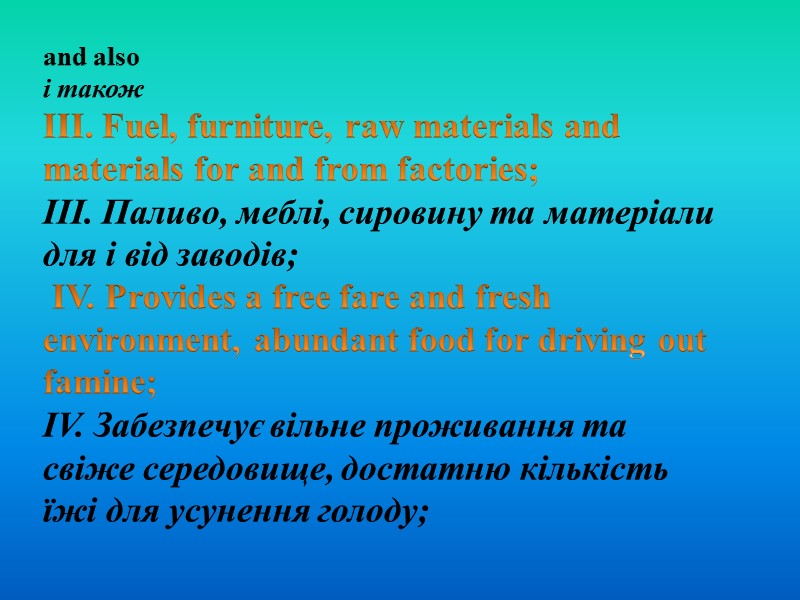
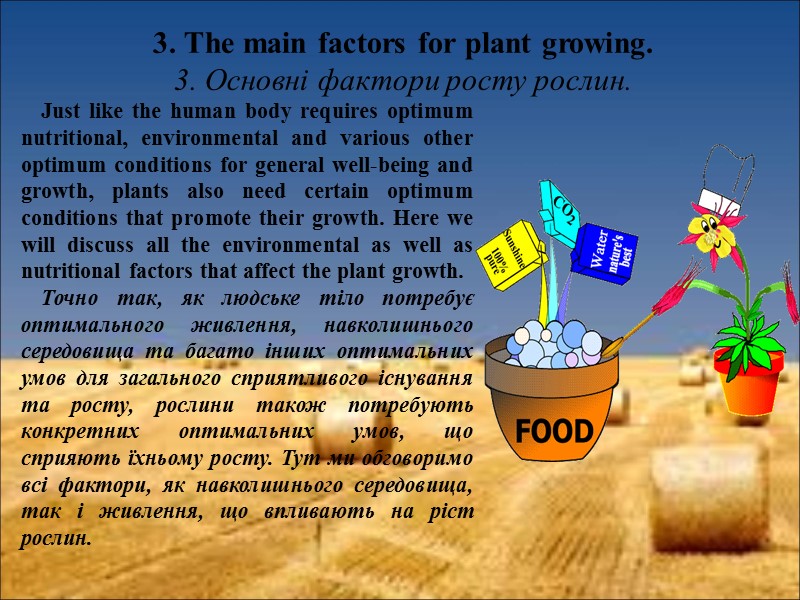
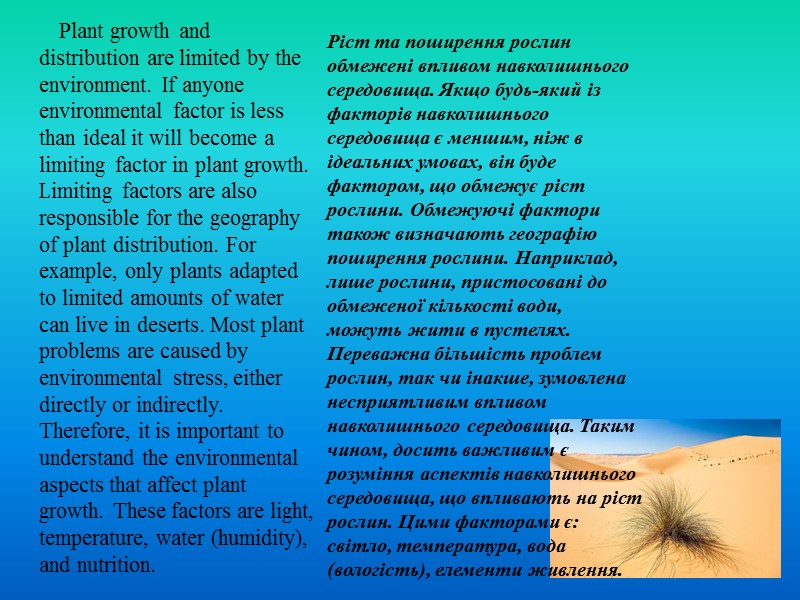
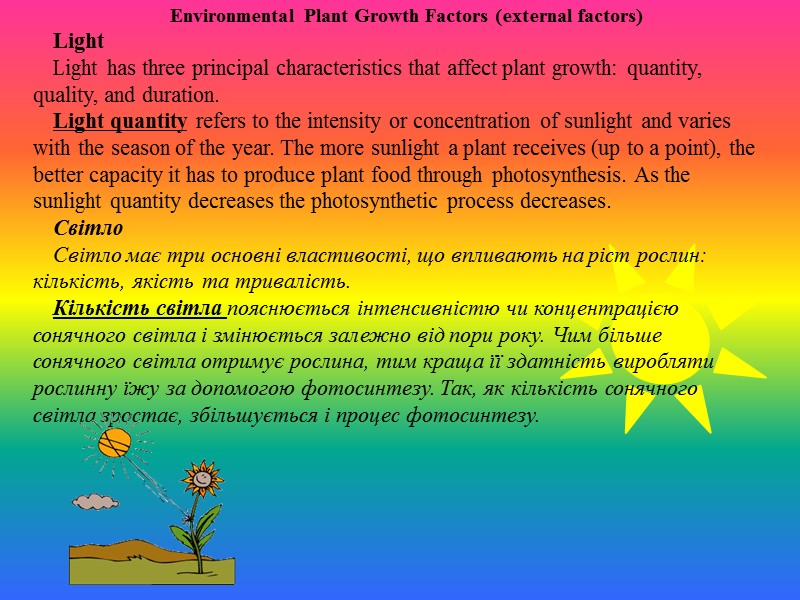
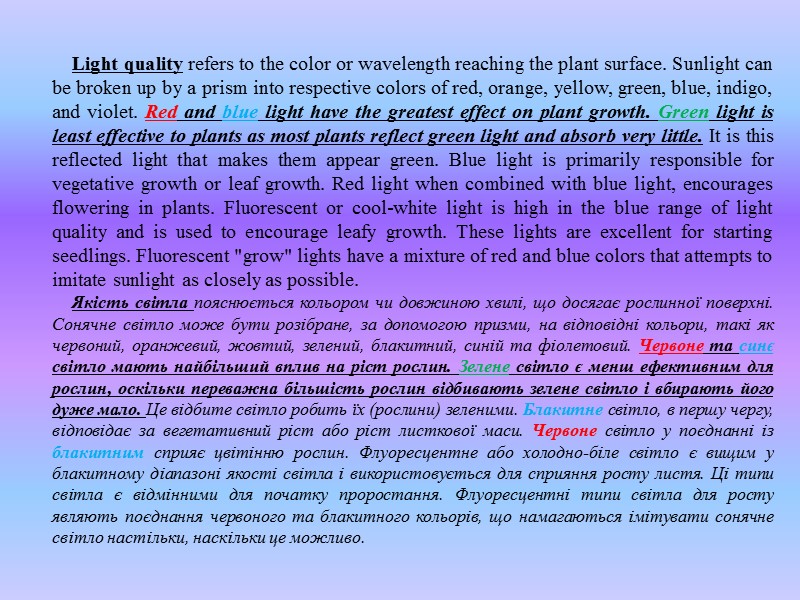
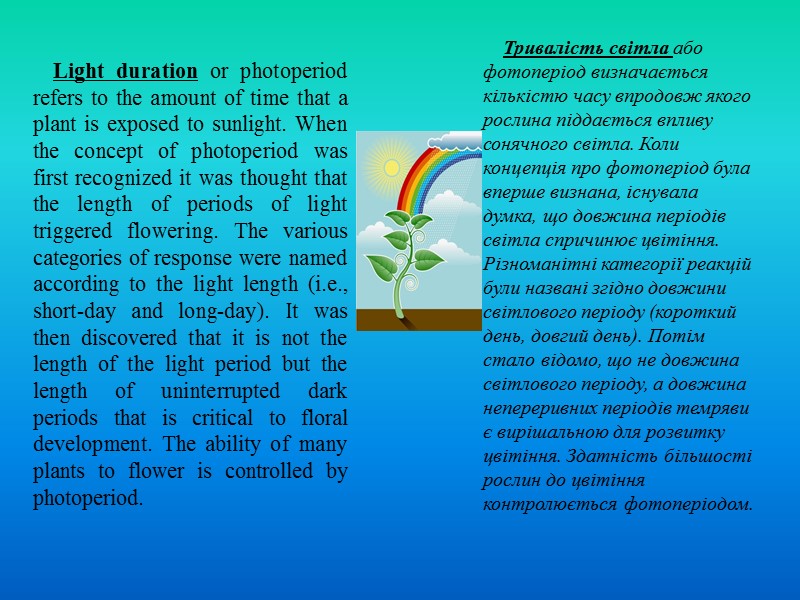
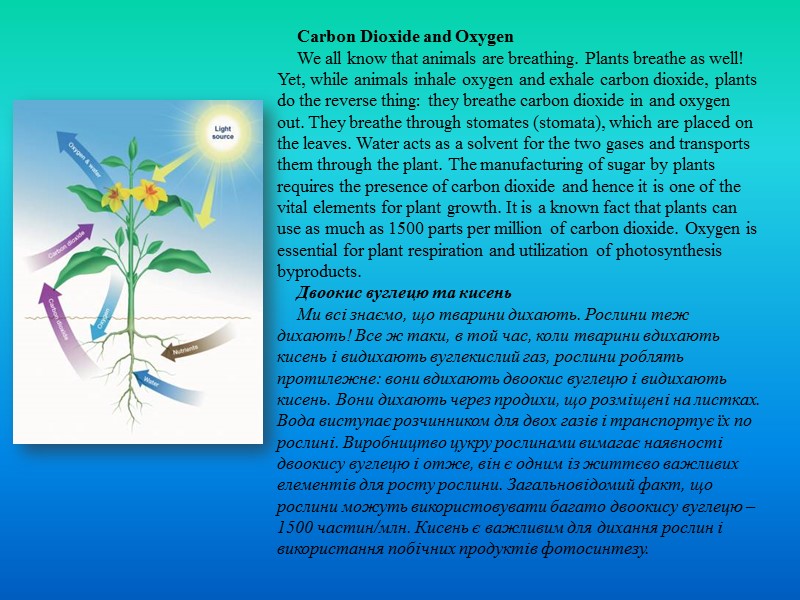
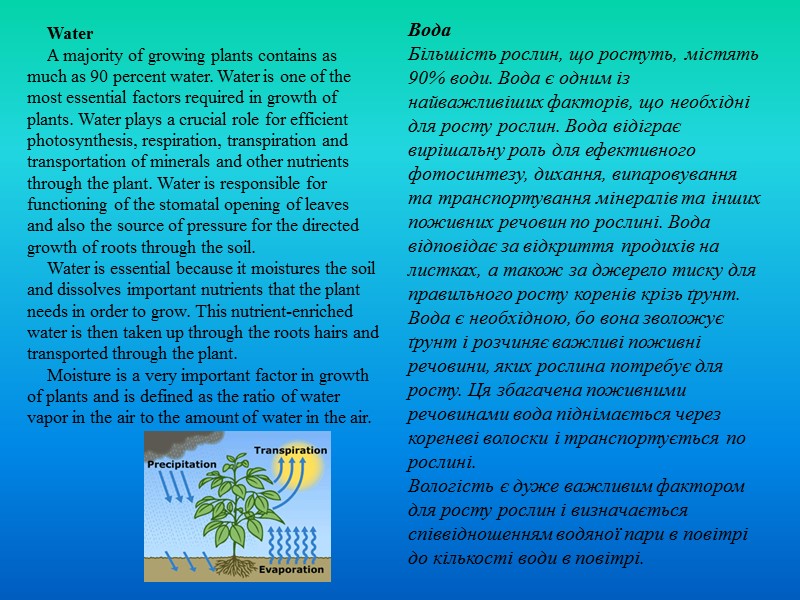

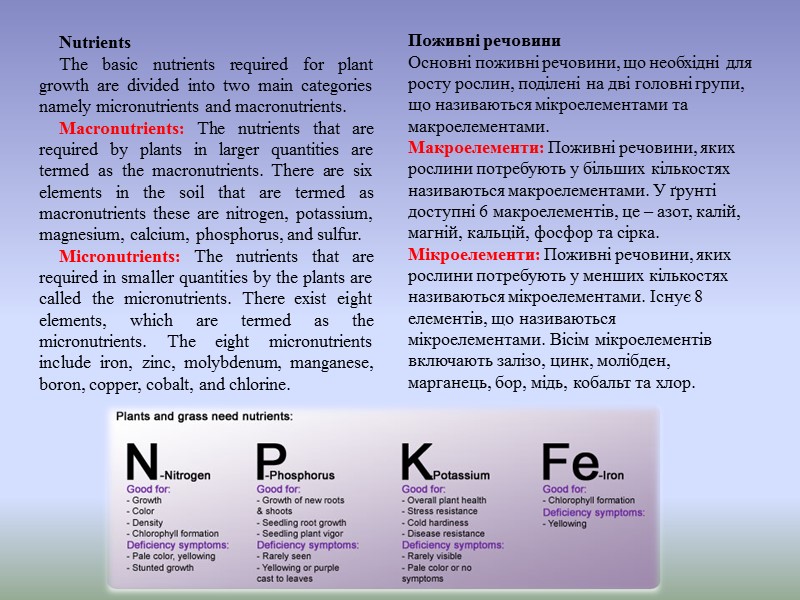
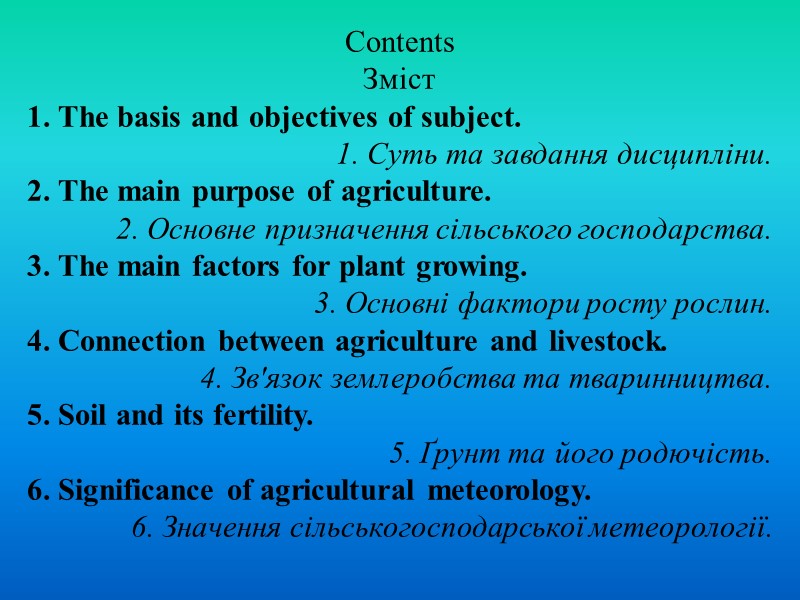




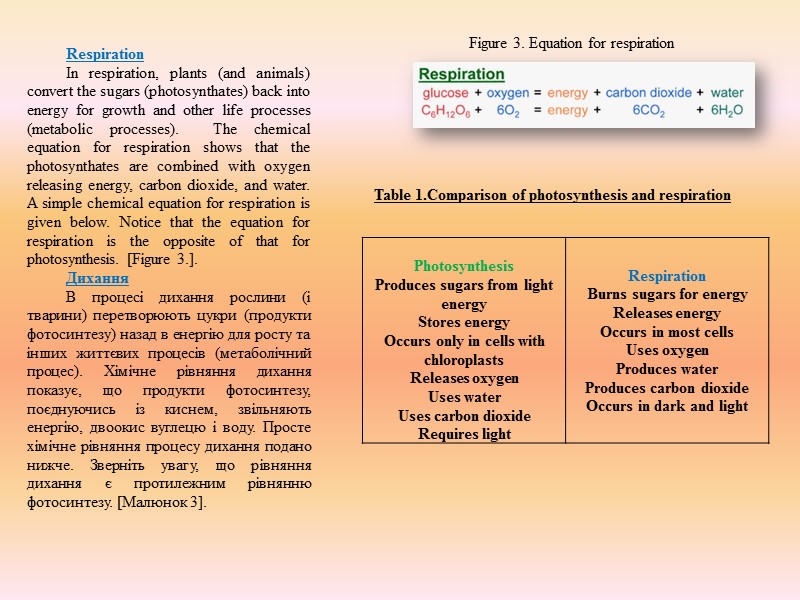




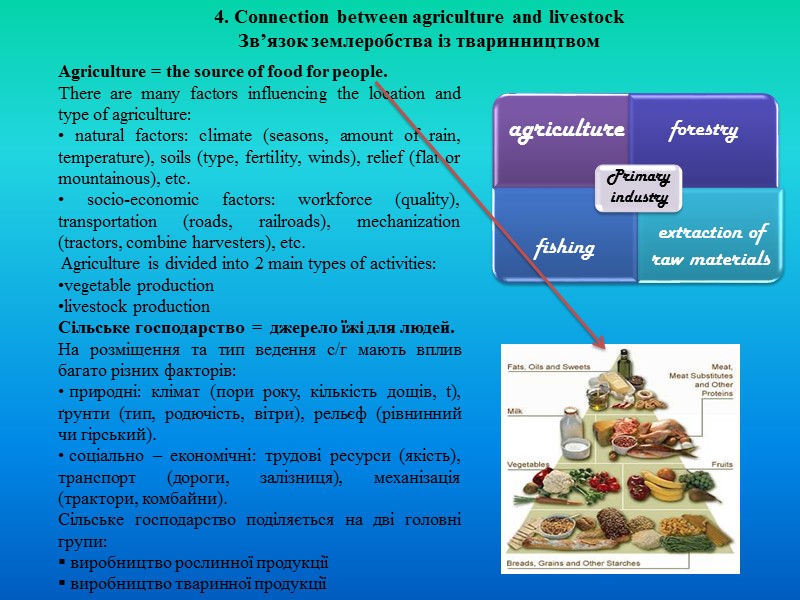
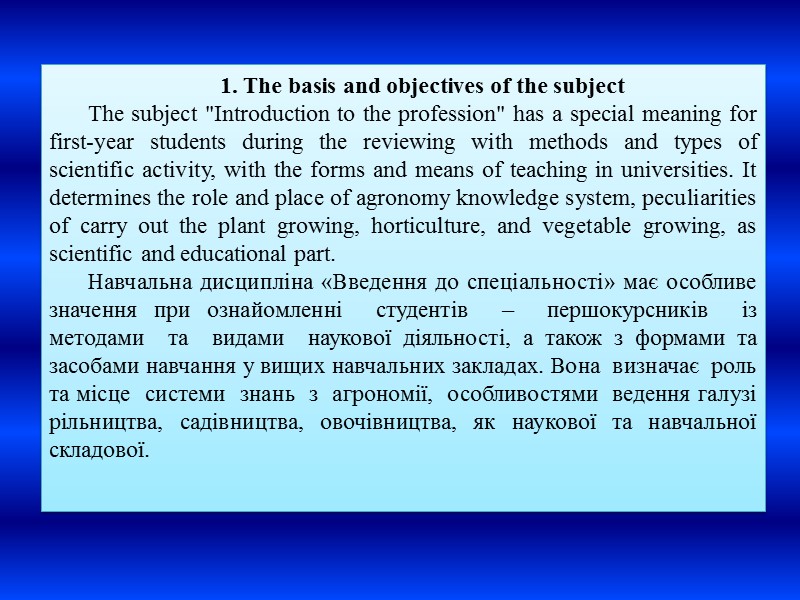


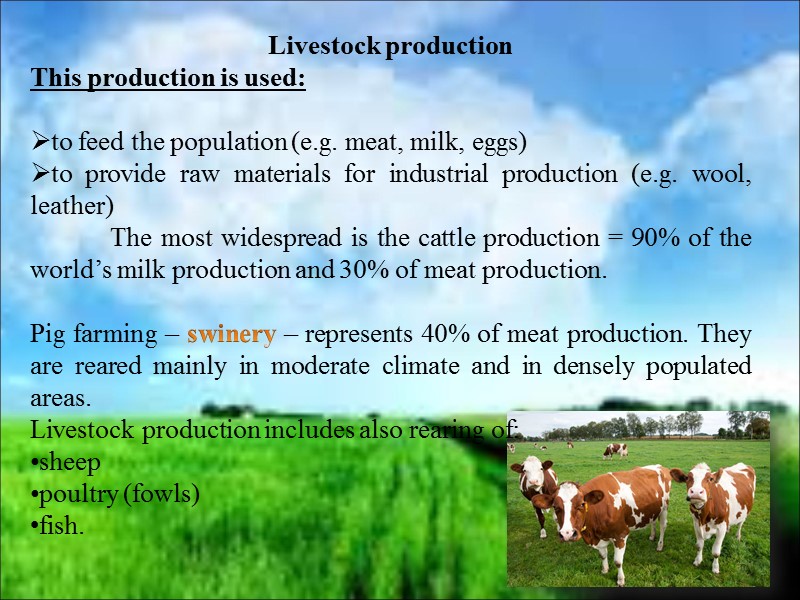

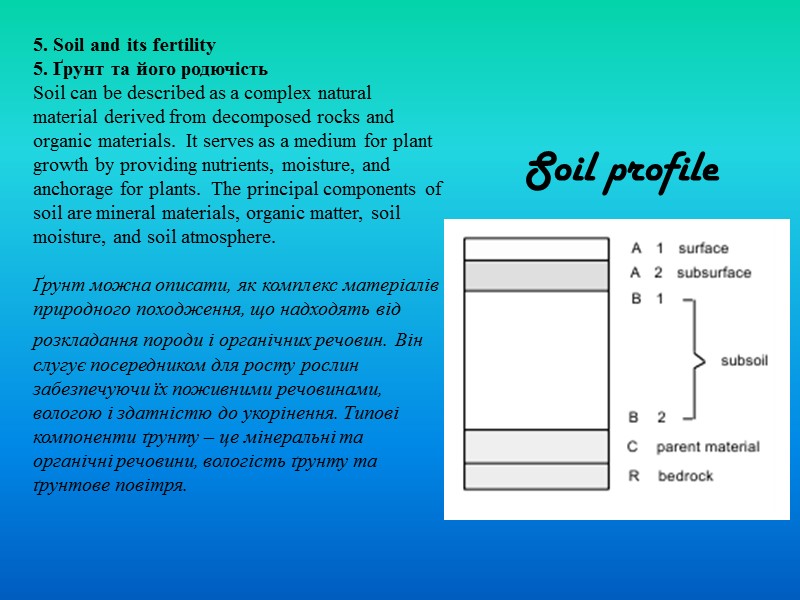
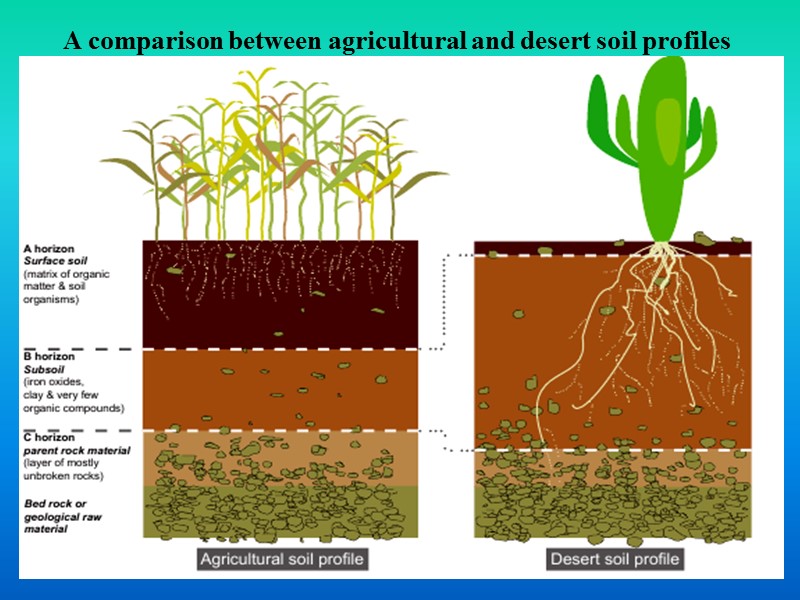


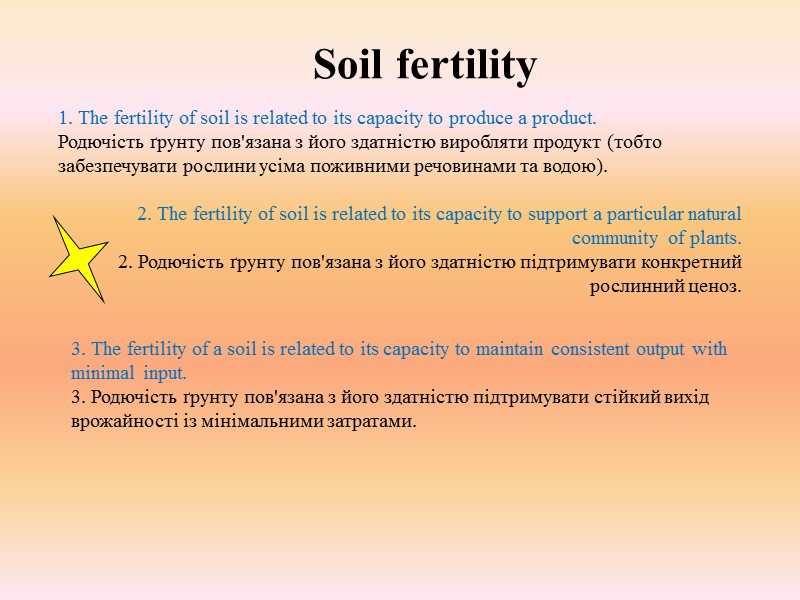
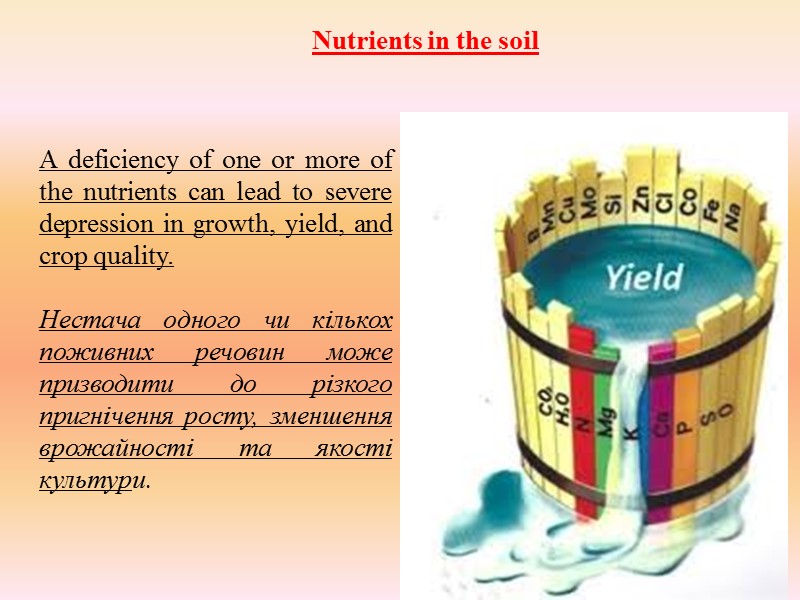
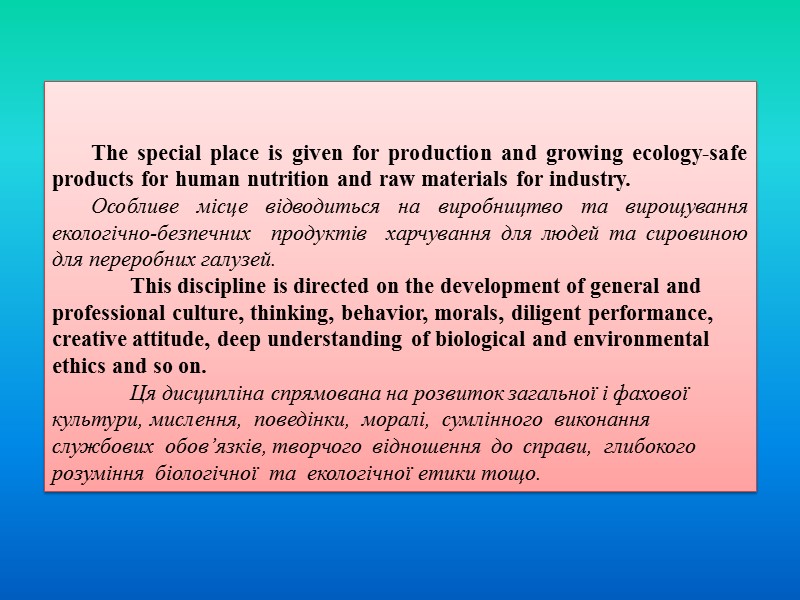
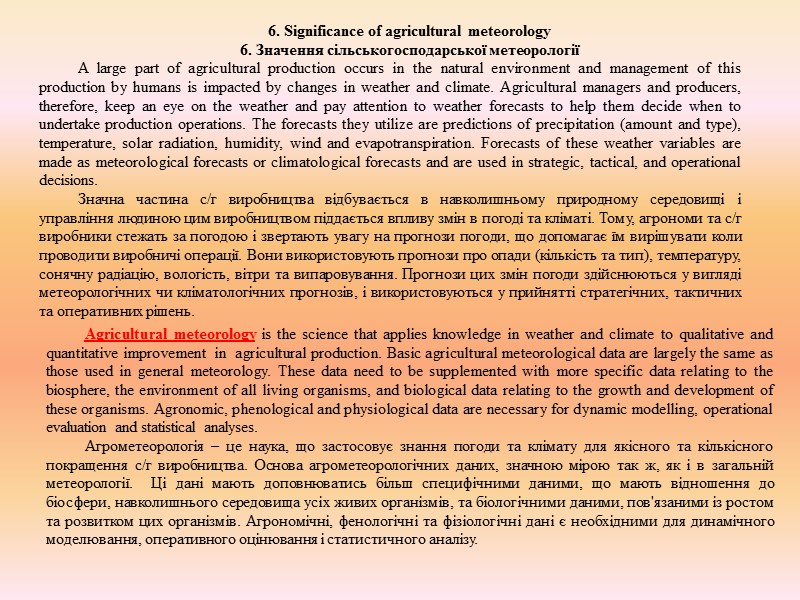

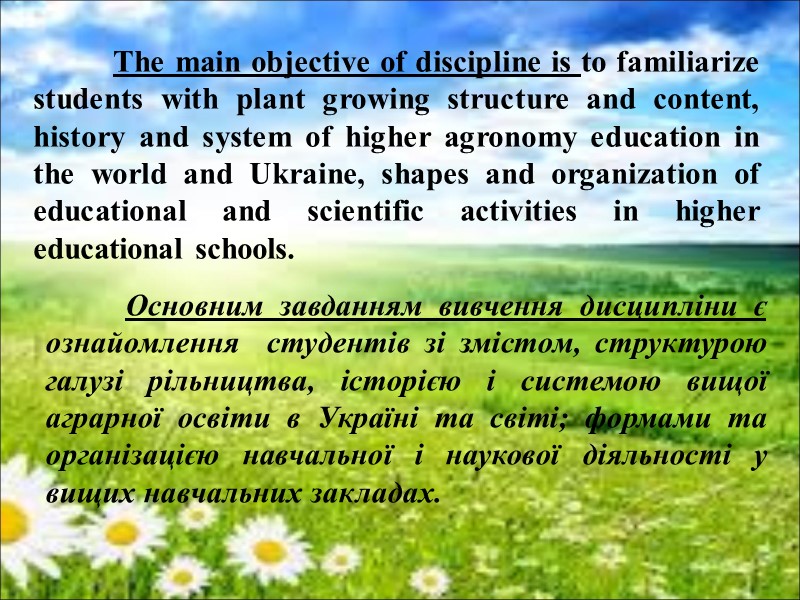
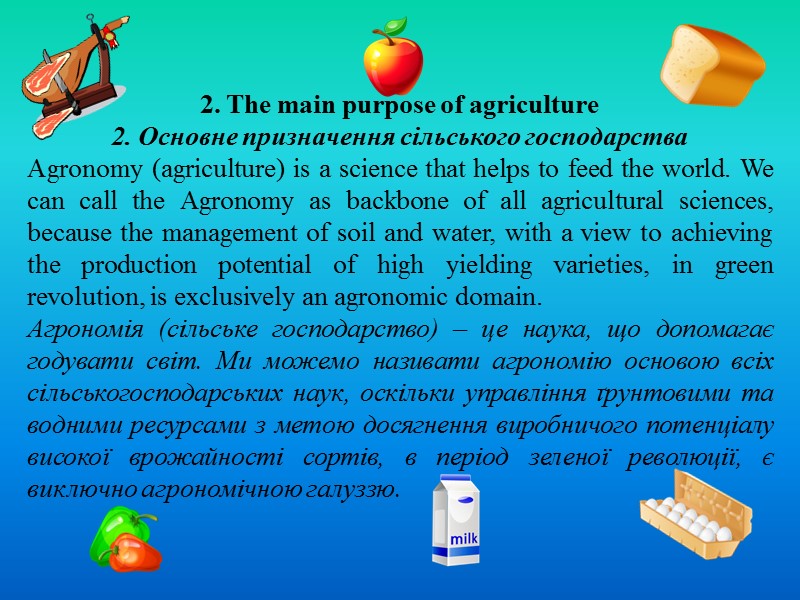
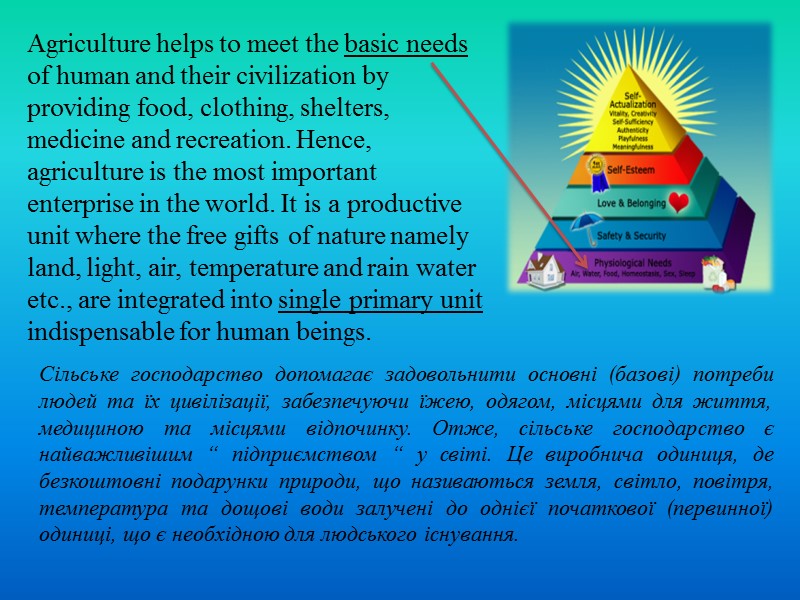
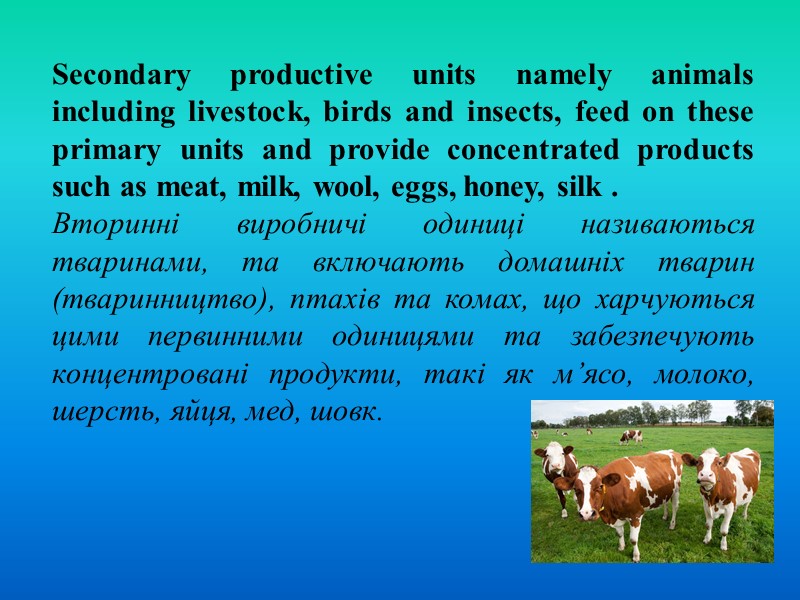
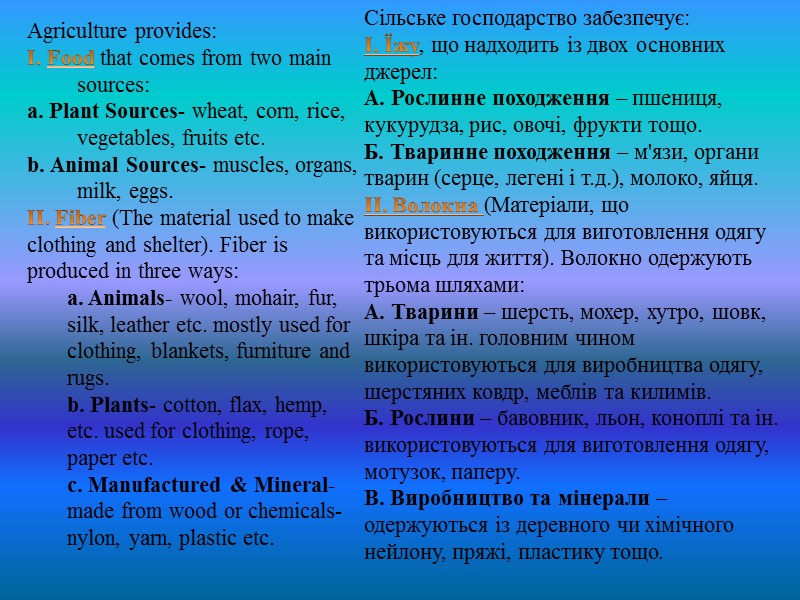
218-lecture_one.ppt
- Количество слайдов: 41
 INTRODUCTION TO THE PROFESSION Lecture 1. Introduction
INTRODUCTION TO THE PROFESSION Lecture 1. Introduction
 Contents Зміст 1. The basis and objectives of subject. 1. Суть та завдання дисципліни. 2. The main purpose of agriculture. 2. Основне призначення сільського господарства. 3. The main factors for plant growing. 3. Основні фактори росту рослин. 4. Connection between agriculture and livestock. 4. Зв'язок землеробства та тваринництва. 5. Soil and its fertility. 5. Ґрунт та його родючість. 6. Significance of agricultural meteorology. 6. Значення сільськогосподарської метеорології.
Contents Зміст 1. The basis and objectives of subject. 1. Суть та завдання дисципліни. 2. The main purpose of agriculture. 2. Основне призначення сільського господарства. 3. The main factors for plant growing. 3. Основні фактори росту рослин. 4. Connection between agriculture and livestock. 4. Зв'язок землеробства та тваринництва. 5. Soil and its fertility. 5. Ґрунт та його родючість. 6. Significance of agricultural meteorology. 6. Значення сільськогосподарської метеорології.
 1. The basis and objectives of the subject The subject "Introduction to the profession" has a special meaning for first-year students during the reviewing with methods and types of scientific activity, with the forms and means of teaching in universities. It determines the role and place of agronomy knowledge system, peculiarities of carry out the plant growing, horticulture, and vegetable growing, as scientific and educational part. Навчальна дисципліна «Введення до спеціальності» має особливе значення при ознайомленні студентів – першокурсників із методами та видами наукової діяльності, а також з формами та засобами навчання у вищих навчальних закладах. Вона визначає роль та місце системи знань з агрономії, особливостями ведення галузі рільництва, садівництва, овочівництва, як наукової та навчальної складової.
1. The basis and objectives of the subject The subject "Introduction to the profession" has a special meaning for first-year students during the reviewing with methods and types of scientific activity, with the forms and means of teaching in universities. It determines the role and place of agronomy knowledge system, peculiarities of carry out the plant growing, horticulture, and vegetable growing, as scientific and educational part. Навчальна дисципліна «Введення до спеціальності» має особливе значення при ознайомленні студентів – першокурсників із методами та видами наукової діяльності, а також з формами та засобами навчання у вищих навчальних закладах. Вона визначає роль та місце системи знань з агрономії, особливостями ведення галузі рільництва, садівництва, овочівництва, як наукової та навчальної складової.
 The special place is given for production and growing ecology-safe products for human nutrition and raw materials for industry. Особливе місце відводиться на виробництво та вирощування екологічно-безпечних продуктів харчування для людей та сировиною для переробних галузей. This discipline is directed on the development of general and professional culture, thinking, behavior, morals, diligent performance, creative attitude, deep understanding of biological and environmental ethics and so on. Ця дисципліна спрямована на розвиток загальної і фахової культури, мислення, поведінки, моралі, сумлінного виконання службових обов’язків, творчого відношення до справи, глибокого розуміння біологічної та екологічної етики тощо.
The special place is given for production and growing ecology-safe products for human nutrition and raw materials for industry. Особливе місце відводиться на виробництво та вирощування екологічно-безпечних продуктів харчування для людей та сировиною для переробних галузей. This discipline is directed on the development of general and professional culture, thinking, behavior, morals, diligent performance, creative attitude, deep understanding of biological and environmental ethics and so on. Ця дисципліна спрямована на розвиток загальної і фахової культури, мислення, поведінки, моралі, сумлінного виконання службових обов’язків, творчого відношення до справи, глибокого розуміння біологічної та екологічної етики тощо.
 The main objective of discipline is to familiarize students with plant growing structure and content, history and system of higher agronomy education in the world and Ukraine, shapes and organization of educational and scientific activities in higher educational schools. Основним завданням вивчення дисципліни є ознайомлення студентів зі змістом, структурою галузі рільництва, історією і системою вищої аграрної освіти в Україні та світі; формами та організацією навчальної і наукової діяльності у вищих навчальних закладах.
The main objective of discipline is to familiarize students with plant growing structure and content, history and system of higher agronomy education in the world and Ukraine, shapes and organization of educational and scientific activities in higher educational schools. Основним завданням вивчення дисципліни є ознайомлення студентів зі змістом, структурою галузі рільництва, історією і системою вищої аграрної освіти в Україні та світі; формами та організацією навчальної і наукової діяльності у вищих навчальних закладах.
 2. The main purpose of agriculture 2. Основне призначення сільського господарства Agronomy (agriculture) is a science that helps to feed the world. We can call the Agronomy as backbone of all agricultural sciences, because the management of soil and water, with a view to achieving the production potential of high yielding varieties, in green revolution, is exclusively an agronomic domain. Агрономія (сільське господарство) – це наука, що допомагає годувати світ. Ми можемо називати агрономію основою всіх сільськогосподарських наук, оскільки управління ґрунтовими та водними ресурсами з метою досягнення виробничого потенціалу високої врожайності сортів, в період зеленої революції, є виключно агрономічною галуззю.
2. The main purpose of agriculture 2. Основне призначення сільського господарства Agronomy (agriculture) is a science that helps to feed the world. We can call the Agronomy as backbone of all agricultural sciences, because the management of soil and water, with a view to achieving the production potential of high yielding varieties, in green revolution, is exclusively an agronomic domain. Агрономія (сільське господарство) – це наука, що допомагає годувати світ. Ми можемо називати агрономію основою всіх сільськогосподарських наук, оскільки управління ґрунтовими та водними ресурсами з метою досягнення виробничого потенціалу високої врожайності сортів, в період зеленої революції, є виключно агрономічною галуззю.
 Agriculture helps to meet the basic needs of human and their civilization by providing food, clothing, shelters, medicine and recreation. Hence, agriculture is the most important enterprise in the world. It is a productive unit where the free gifts of nature namely land, light, air, temperature and rain water etc., are integrated into single primary unit indispensable for human beings. Сільське господарство допомагає задовольнити основні (базові) потреби людей та їх цивілізації, забезпечуючи їжею, одягом, місцями для життя, медициною та місцями відпочинку. Отже, сільське господарство є найважливішим “ підприємством “ у світі. Це виробнича одиниця, де безкоштовні подарунки природи, що називаються земля, світло, повітря, температура та дощові води залучені до однієї початкової (первинної) одиниці, що є необхідною для людського існування.
Agriculture helps to meet the basic needs of human and their civilization by providing food, clothing, shelters, medicine and recreation. Hence, agriculture is the most important enterprise in the world. It is a productive unit where the free gifts of nature namely land, light, air, temperature and rain water etc., are integrated into single primary unit indispensable for human beings. Сільське господарство допомагає задовольнити основні (базові) потреби людей та їх цивілізації, забезпечуючи їжею, одягом, місцями для життя, медициною та місцями відпочинку. Отже, сільське господарство є найважливішим “ підприємством “ у світі. Це виробнича одиниця, де безкоштовні подарунки природи, що називаються земля, світло, повітря, температура та дощові води залучені до однієї початкової (первинної) одиниці, що є необхідною для людського існування.
 Secondary productive units namely animals including livestock, birds and insects, feed on these primary units and provide concentrated products such as meat, milk, wool, eggs, honey, silk . Вторинні виробничі одиниці називаються тваринами, та включають домашніх тварин (тваринництво), птахів та комах, що харчуються цими первинними одиницями та забезпечують концентровані продукти, такі як м’ясо, молоко, шерсть, яйця, мед, шовк.
Secondary productive units namely animals including livestock, birds and insects, feed on these primary units and provide concentrated products such as meat, milk, wool, eggs, honey, silk . Вторинні виробничі одиниці називаються тваринами, та включають домашніх тварин (тваринництво), птахів та комах, що харчуються цими первинними одиницями та забезпечують концентровані продукти, такі як м’ясо, молоко, шерсть, яйця, мед, шовк.
 Agriculture provides: І. Food that comes from two main sources: a. Plant Sources- wheat, corn, rice, vegetables, fruits etc. b. Animal Sources- muscles, organs, milk, eggs. II. Fiber (The material used to make clothing and shelter). Fiber is produced in three ways: a. Animals- wool, mohair, fur, silk, leather etc. mostly used for clothing, blankets, furniture and rugs. b. Plants- cotton, flax, hemp, etc. used for clothing, rope, paper etc. c. Manufactured & Mineral- made from wood or chemicals- nylon, yarn, plastic etc. Сільське господарство забезпечує: І. Їжу, що надходить із двох основних джерел: А. Рослинне походження – пшениця, кукурудза, рис, овочі, фрукти тощо. Б. Тваринне походження – м'язи, органи тварин (серце, легені і т.д.), молоко, яйця. ІІ. Волокна (Матеріали, що використовуються для виготовлення одягу та місць для життя). Волокно одержують трьома шляхами: А. Тварини – шерсть, мохер, хутро, шовк, шкіра та ін. головним чином використовуються для виробництва одягу, шерстяних ковдр, меблів та килимів. Б. Рослини – бавовник, льон, коноплі та ін. використовуються для виготовлення одягу, мотузок, паперу. В. Виробництво та мінерали – одержуються із деревного чи хімічного нейлону, пряжі, пластику тощо.
Agriculture provides: І. Food that comes from two main sources: a. Plant Sources- wheat, corn, rice, vegetables, fruits etc. b. Animal Sources- muscles, organs, milk, eggs. II. Fiber (The material used to make clothing and shelter). Fiber is produced in three ways: a. Animals- wool, mohair, fur, silk, leather etc. mostly used for clothing, blankets, furniture and rugs. b. Plants- cotton, flax, hemp, etc. used for clothing, rope, paper etc. c. Manufactured & Mineral- made from wood or chemicals- nylon, yarn, plastic etc. Сільське господарство забезпечує: І. Їжу, що надходить із двох основних джерел: А. Рослинне походження – пшениця, кукурудза, рис, овочі, фрукти тощо. Б. Тваринне походження – м'язи, органи тварин (серце, легені і т.д.), молоко, яйця. ІІ. Волокна (Матеріали, що використовуються для виготовлення одягу та місць для життя). Волокно одержують трьома шляхами: А. Тварини – шерсть, мохер, хутро, шовк, шкіра та ін. головним чином використовуються для виробництва одягу, шерстяних ковдр, меблів та килимів. Б. Рослини – бавовник, льон, коноплі та ін. використовуються для виготовлення одягу, мотузок, паперу. В. Виробництво та мінерали – одержуються із деревного чи хімічного нейлону, пряжі, пластику тощо.
 and also і також III. Fuel, furniture, raw materials and materials for and from factories; ІІІ. Паливо, меблі, сировину та матеріали для і від заводів; IV. Provides a free fare and fresh environment, abundant food for driving out famine; ІV. Забезпечує вільне проживання та свіже середовище, достатню кількість їжі для усунення голоду;
and also і також III. Fuel, furniture, raw materials and materials for and from factories; ІІІ. Паливо, меблі, сировину та матеріали для і від заводів; IV. Provides a free fare and fresh environment, abundant food for driving out famine; ІV. Забезпечує вільне проживання та свіже середовище, достатню кількість їжі для усунення голоду;
 3. The main factors for plant growing. 3. Основні фактори росту рослин. Just like the human body requires optimum nutritional, environmental and various other optimum conditions for general well-being and growth, plants also need certain optimum conditions that promote their growth. Here we will discuss all the environmental as well as nutritional factors that affect the plant growth. Точно так, як людське тіло потребує оптимального живлення, навколишнього середовища та багато інших оптимальних умов для загального сприятливого існування та росту, рослини також потребують конкретних оптимальних умов, що сприяють їхньому росту. Тут ми обговоримо всі фактори, як навколишнього середовища, так і живлення, що впливають на ріст рослин.
3. The main factors for plant growing. 3. Основні фактори росту рослин. Just like the human body requires optimum nutritional, environmental and various other optimum conditions for general well-being and growth, plants also need certain optimum conditions that promote their growth. Here we will discuss all the environmental as well as nutritional factors that affect the plant growth. Точно так, як людське тіло потребує оптимального живлення, навколишнього середовища та багато інших оптимальних умов для загального сприятливого існування та росту, рослини також потребують конкретних оптимальних умов, що сприяють їхньому росту. Тут ми обговоримо всі фактори, як навколишнього середовища, так і живлення, що впливають на ріст рослин.
 Plant growth and distribution are limited by the environment. If anyone environmental factor is less than ideal it will become a limiting factor in plant growth. Limiting factors are also responsible for the geography of plant distribution. For example, only plants adapted to limited amounts of water can live in deserts. Most plant problems are caused by environmental stress, either directly or indirectly. Therefore, it is important to understand the environmental aspects that affect plant growth. These factors are light, temperature, water (humidity), and nutrition. Ріст та поширення рослин обмежені впливом навколишнього середовища. Якщо будь-який із факторів навколишнього середовища є меншим, ніж в ідеальних умовах, він буде фактором, що обмежує ріст рослини. Обмежуючі фактори також визначають географію поширення рослини. Наприклад, лише рослини, пристосовані до обмеженої кількості води, можуть жити в пустелях. Переважна більшість проблем рослин, так чи інакше, зумовлена несприятливим впливом навколишнього середовища. Таким чином, досить важливим є розуміння аспектів навколишнього середовища, що впливають на ріст рослин. Цими факторами є: світло, температура, вода (вологість), елементи живлення.
Plant growth and distribution are limited by the environment. If anyone environmental factor is less than ideal it will become a limiting factor in plant growth. Limiting factors are also responsible for the geography of plant distribution. For example, only plants adapted to limited amounts of water can live in deserts. Most plant problems are caused by environmental stress, either directly or indirectly. Therefore, it is important to understand the environmental aspects that affect plant growth. These factors are light, temperature, water (humidity), and nutrition. Ріст та поширення рослин обмежені впливом навколишнього середовища. Якщо будь-який із факторів навколишнього середовища є меншим, ніж в ідеальних умовах, він буде фактором, що обмежує ріст рослини. Обмежуючі фактори також визначають географію поширення рослини. Наприклад, лише рослини, пристосовані до обмеженої кількості води, можуть жити в пустелях. Переважна більшість проблем рослин, так чи інакше, зумовлена несприятливим впливом навколишнього середовища. Таким чином, досить важливим є розуміння аспектів навколишнього середовища, що впливають на ріст рослин. Цими факторами є: світло, температура, вода (вологість), елементи живлення.
 Environmental Plant Growth Factors (external factors) Light Light has three principal characteristics that affect plant growth: quantity, quality, and duration. Light quantity refers to the intensity or concentration of sunlight and varies with the season of the year. The more sunlight a plant receives (up to a point), the better capacity it has to produce plant food through photosynthesis. As the sunlight quantity decreases the photosynthetic process decreases. Світло Світло має три основні властивості, що впливають на ріст рослин: кількість, якість та тривалість. Кількість світла пояснюється інтенсивністю чи концентрацією сонячного світла і змінюється залежно від пори року. Чим більше сонячного світла отримує рослина, тим краща її здатність виробляти рослинну їжу за допомогою фотосинтезу. Так, як кількість сонячного світла зростає, збільшується і процес фотосинтезу.
Environmental Plant Growth Factors (external factors) Light Light has three principal characteristics that affect plant growth: quantity, quality, and duration. Light quantity refers to the intensity or concentration of sunlight and varies with the season of the year. The more sunlight a plant receives (up to a point), the better capacity it has to produce plant food through photosynthesis. As the sunlight quantity decreases the photosynthetic process decreases. Світло Світло має три основні властивості, що впливають на ріст рослин: кількість, якість та тривалість. Кількість світла пояснюється інтенсивністю чи концентрацією сонячного світла і змінюється залежно від пори року. Чим більше сонячного світла отримує рослина, тим краща її здатність виробляти рослинну їжу за допомогою фотосинтезу. Так, як кількість сонячного світла зростає, збільшується і процес фотосинтезу.
 Light quality refers to the color or wavelength reaching the plant surface. Sunlight can be broken up by a prism into respective colors of red, orange, yellow, green, blue, indigo, and violet. Red and blue light have the greatest effect on plant growth. Green light is least effective to plants as most plants reflect green light and absorb very little. It is this reflected light that makes them appear green. Blue light is primarily responsible for vegetative growth or leaf growth. Red light when combined with blue light, encourages flowering in plants. Fluorescent or cool-white light is high in the blue range of light quality and is used to encourage leafy growth. These lights are excellent for starting seedlings. Fluorescent "grow" lights have a mixture of red and blue colors that attempts to imitate sunlight as closely as possible. Якість світла пояснюється кольором чи довжиною хвилі, що досягає рослинної поверхні. Сонячне світло може бути розібране, за допомогою призми, на відповідні кольори, такі як червоний, оранжевий, жовтий, зелений, блакитний, синій та фіолетовий. Червоне та синє світло мають найбільший вплив на ріст рослин. Зелене світло є менш ефективним для рослин, оскільки переважна більшість рослин відбивають зелене світло і вбирають його дуже мало. Це відбите світло робить їх (рослини) зеленими. Блакитне світло, в першу чергу, відповідає за вегетативний ріст або ріст листкової маси. Червоне світло у поєднанні із блакитним сприяє цвітінню рослин. Флуоресцентне або холодно-біле світло є вищим у блакитному діапазоні якості світла і використовується для сприяння росту листя. Ці типи світла є відмінними для початку проростання. Флуоресцентні типи світла для росту являють поєднання червоного та блакитного кольорів, що намагаються імітувати сонячне світло настільки, наскільки це можливо.
Light quality refers to the color or wavelength reaching the plant surface. Sunlight can be broken up by a prism into respective colors of red, orange, yellow, green, blue, indigo, and violet. Red and blue light have the greatest effect on plant growth. Green light is least effective to plants as most plants reflect green light and absorb very little. It is this reflected light that makes them appear green. Blue light is primarily responsible for vegetative growth or leaf growth. Red light when combined with blue light, encourages flowering in plants. Fluorescent or cool-white light is high in the blue range of light quality and is used to encourage leafy growth. These lights are excellent for starting seedlings. Fluorescent "grow" lights have a mixture of red and blue colors that attempts to imitate sunlight as closely as possible. Якість світла пояснюється кольором чи довжиною хвилі, що досягає рослинної поверхні. Сонячне світло може бути розібране, за допомогою призми, на відповідні кольори, такі як червоний, оранжевий, жовтий, зелений, блакитний, синій та фіолетовий. Червоне та синє світло мають найбільший вплив на ріст рослин. Зелене світло є менш ефективним для рослин, оскільки переважна більшість рослин відбивають зелене світло і вбирають його дуже мало. Це відбите світло робить їх (рослини) зеленими. Блакитне світло, в першу чергу, відповідає за вегетативний ріст або ріст листкової маси. Червоне світло у поєднанні із блакитним сприяє цвітінню рослин. Флуоресцентне або холодно-біле світло є вищим у блакитному діапазоні якості світла і використовується для сприяння росту листя. Ці типи світла є відмінними для початку проростання. Флуоресцентні типи світла для росту являють поєднання червоного та блакитного кольорів, що намагаються імітувати сонячне світло настільки, наскільки це можливо.
 Light duration or photoperiod refers to the amount of time that a plant is exposed to sunlight. When the concept of photoperiod was first recognized it was thought that the length of periods of light triggered flowering. The various categories of response were named according to the light length (i.e., short-day and long-day). It was then discovered that it is not the length of the light period but the length of uninterrupted dark periods that is critical to floral development. The ability of many plants to flower is controlled by photoperiod. Тривалість світла або фотоперіод визначається кількістю часу впродовж якого рослина піддається впливу сонячного світла. Коли концепція про фотоперіод була вперше визнана, існувала думка, що довжина періодів світла спричинює цвітіння. Різноманітні категорії реакцій були названі згідно довжини світлового періоду (короткий день, довгий день). Потім стало відомо, що не довжина світлового періоду, а довжина непереривних періодів темряви є вирішальною для розвитку цвітіння. Здатність більшості рослин до цвітіння контролюється фотоперіодом.
Light duration or photoperiod refers to the amount of time that a plant is exposed to sunlight. When the concept of photoperiod was first recognized it was thought that the length of periods of light triggered flowering. The various categories of response were named according to the light length (i.e., short-day and long-day). It was then discovered that it is not the length of the light period but the length of uninterrupted dark periods that is critical to floral development. The ability of many plants to flower is controlled by photoperiod. Тривалість світла або фотоперіод визначається кількістю часу впродовж якого рослина піддається впливу сонячного світла. Коли концепція про фотоперіод була вперше визнана, існувала думка, що довжина періодів світла спричинює цвітіння. Різноманітні категорії реакцій були названі згідно довжини світлового періоду (короткий день, довгий день). Потім стало відомо, що не довжина світлового періоду, а довжина непереривних періодів темряви є вирішальною для розвитку цвітіння. Здатність більшості рослин до цвітіння контролюється фотоперіодом.
 Carbon Dioxide and Oxygen We all know that animals are breathing. Plants breathe as well! Yet, while animals inhale oxygen and exhale carbon dioxide, plants do the reverse thing: they breathe carbon dioxide in and oxygen out. They breathe through stomates (stomata), which are placed on the leaves. Water acts as a solvent for the two gases and transports them through the plant. The manufacturing of sugar by plants requires the presence of carbon dioxide and hence it is one of the vital elements for plant growth. It is a known fact that plants can use as much as 1500 parts per million of carbon dioxide. Oxygen is essential for plant respiration and utilization of photosynthesis byproducts. Двоокис вуглецю та кисень Ми всі знаємо, що тварини дихають. Рослини теж дихають! Все ж таки, в той час, коли тварини вдихають кисень і видихають вуглекислий газ, рослини роблять протилежне: вони вдихають двоокис вуглецю і видихають кисень. Вони дихають через продихи, що розміщені на листках. Вода виступає розчинником для двох газів і транспортує їх по рослині. Виробництво цукру рослинами вимагає наявності двоокису вуглецю і отже, він є одним із життєво важливих елементів для росту рослини. Загальновідомий факт, що рослини можуть використовувати багато двоокису вуглецю – 1500 частин/млн. Кисень є важливим для дихання рослин і використання побічних продуктів фотосинтезу.
Carbon Dioxide and Oxygen We all know that animals are breathing. Plants breathe as well! Yet, while animals inhale oxygen and exhale carbon dioxide, plants do the reverse thing: they breathe carbon dioxide in and oxygen out. They breathe through stomates (stomata), which are placed on the leaves. Water acts as a solvent for the two gases and transports them through the plant. The manufacturing of sugar by plants requires the presence of carbon dioxide and hence it is one of the vital elements for plant growth. It is a known fact that plants can use as much as 1500 parts per million of carbon dioxide. Oxygen is essential for plant respiration and utilization of photosynthesis byproducts. Двоокис вуглецю та кисень Ми всі знаємо, що тварини дихають. Рослини теж дихають! Все ж таки, в той час, коли тварини вдихають кисень і видихають вуглекислий газ, рослини роблять протилежне: вони вдихають двоокис вуглецю і видихають кисень. Вони дихають через продихи, що розміщені на листках. Вода виступає розчинником для двох газів і транспортує їх по рослині. Виробництво цукру рослинами вимагає наявності двоокису вуглецю і отже, він є одним із життєво важливих елементів для росту рослини. Загальновідомий факт, що рослини можуть використовувати багато двоокису вуглецю – 1500 частин/млн. Кисень є важливим для дихання рослин і використання побічних продуктів фотосинтезу.
 Water A majority of growing plants contains as much as 90 percent water. Water is one of the most essential factors required in growth of plants. Water plays a crucial role for efficient photosynthesis, respiration, transpiration and transportation of minerals and other nutrients through the plant. Water is responsible for functioning of the stomatal opening of leaves and also the source of pressure for the directed growth of roots through the soil. Water is essential because it moistures the soil and dissolves important nutrients that the plant needs in order to grow. This nutrient-enriched water is then taken up through the roots hairs and transported through the plant. Moisture is a very important factor in growth of plants and is defined as the ratio of water vapor in the air to the amount of water in the air. Вода Більшість рослин, що ростуть, містять 90% води. Вода є одним із найважливіших факторів, що необхідні для росту рослин. Вода відіграє вирішальну роль для ефективного фотосинтезу, дихання, випаровування та транспортування мінералів та інших поживних речовин по рослині. Вода відповідає за відкриття продихів на листках, а також за джерело тиску для правильного росту коренів крізь ґрунт. Вода є необхідною, бо вона зволожує ґрунт і розчиняє важливі поживні речовини, яких рослина потребує для росту. Ця збагачена поживними речовинами вода піднімається через кореневі волоски і транспортується по рослині. Вологість є дуже важливим фактором для росту рослин і визначається співвідношенням водяної пари в повітрі до кількості води в повітрі.
Water A majority of growing plants contains as much as 90 percent water. Water is one of the most essential factors required in growth of plants. Water plays a crucial role for efficient photosynthesis, respiration, transpiration and transportation of minerals and other nutrients through the plant. Water is responsible for functioning of the stomatal opening of leaves and also the source of pressure for the directed growth of roots through the soil. Water is essential because it moistures the soil and dissolves important nutrients that the plant needs in order to grow. This nutrient-enriched water is then taken up through the roots hairs and transported through the plant. Moisture is a very important factor in growth of plants and is defined as the ratio of water vapor in the air to the amount of water in the air. Вода Більшість рослин, що ростуть, містять 90% води. Вода є одним із найважливіших факторів, що необхідні для росту рослин. Вода відіграє вирішальну роль для ефективного фотосинтезу, дихання, випаровування та транспортування мінералів та інших поживних речовин по рослині. Вода відповідає за відкриття продихів на листках, а також за джерело тиску для правильного росту коренів крізь ґрунт. Вода є необхідною, бо вона зволожує ґрунт і розчиняє важливі поживні речовини, яких рослина потребує для росту. Ця збагачена поживними речовинами вода піднімається через кореневі волоски і транспортується по рослині. Вологість є дуже важливим фактором для росту рослин і визначається співвідношенням водяної пари в повітрі до кількості води в повітрі.
 Temperature Temperature is a crucial element that influences the growth of plants. Temperature of the surrounding atmosphere as well as the temperature of the soil matters for the plant growth. Optimum temperature is one of the pre-requisites for many of the plant processes, like photosynthesis, respiration, germination, and flowering. Температура Температура є вирішальним елементом із тих, що впливають на ріст рослин. Температура атмосфери, так як, і температура ґрунту має значення для росту рослин. Оптимальна температура є одним із попередньо необхідних показників для багатьох рослин процесів, таких як фотосинтез, дихання, проростання та цвітіння.
Temperature Temperature is a crucial element that influences the growth of plants. Temperature of the surrounding atmosphere as well as the temperature of the soil matters for the plant growth. Optimum temperature is one of the pre-requisites for many of the plant processes, like photosynthesis, respiration, germination, and flowering. Температура Температура є вирішальним елементом із тих, що впливають на ріст рослин. Температура атмосфери, так як, і температура ґрунту має значення для росту рослин. Оптимальна температура є одним із попередньо необхідних показників для багатьох рослин процесів, таких як фотосинтез, дихання, проростання та цвітіння.
 Nutrients The basic nutrients required for plant growth are divided into two main categories namely micronutrients and macronutrients. Macronutrients: The nutrients that are required by plants in larger quantities are termed as the macronutrients. There are six elements in the soil that are termed as macronutrients these are nitrogen, potassium, magnesium, calcium, phosphorus, and sulfur. Micronutrients: The nutrients that are required in smaller quantities by the plants are called the micronutrients. There exist eight elements, which are termed as the micronutrients. The eight micronutrients include iron, zinc, molybdenum, manganese, boron, copper, cobalt, and chlorine. Поживні речовини Основні поживні речовини, що необхідні для росту рослин, поділені на дві головні групи, що називаються мікроелементами та макроелементами. Макроелементи: Поживні речовини, яких рослини потребують у більших кількостях називаються макроелементами. У ґрунті доступні 6 макроелементів, це – азот, калій, магній, кальцій, фосфор та сірка. Мікроелементи: Поживні речовини, яких рослини потребують у менших кількостях називаються мікроелементами. Існує 8 елементів, що називаються мікроелементами. Вісім мікроелементів включають залізо, цинк, молібден, марганець, бор, мідь, кобальт та хлор.
Nutrients The basic nutrients required for plant growth are divided into two main categories namely micronutrients and macronutrients. Macronutrients: The nutrients that are required by plants in larger quantities are termed as the macronutrients. There are six elements in the soil that are termed as macronutrients these are nitrogen, potassium, magnesium, calcium, phosphorus, and sulfur. Micronutrients: The nutrients that are required in smaller quantities by the plants are called the micronutrients. There exist eight elements, which are termed as the micronutrients. The eight micronutrients include iron, zinc, molybdenum, manganese, boron, copper, cobalt, and chlorine. Поживні речовини Основні поживні речовини, що необхідні для росту рослин, поділені на дві головні групи, що називаються мікроелементами та макроелементами. Макроелементи: Поживні речовини, яких рослини потребують у більших кількостях називаються макроелементами. У ґрунті доступні 6 макроелементів, це – азот, калій, магній, кальцій, фосфор та сірка. Мікроелементи: Поживні речовини, яких рослини потребують у менших кількостях називаються мікроелементами. Існує 8 елементів, що називаються мікроелементами. Вісім мікроелементів включають залізо, цинк, молібден, марганець, бор, мідь, кобальт та хлор.


 The three major functions that are basic to plant growth and development are: Photosynthesis – The process of capturing light energy and converting it to sugar energy, in the presence of chlorophyll using carbon dioxide and water. Respiration – The process of metabolizing (burning) sugars to yield energy for growth, reproduction, and other life processes. Transpiration – The loss of water vapor through the stomata of leaves. Три головні функції, що є основою рослинного росту та розвитку: Фотосинтез – процес зберігання світлової енергії і перетворення її в цукрову енергію, при наявності хлорофілу, із використанням двоокису вуглецю та води. Дихання – процес метаболізму (спалювання) цукрів з метою отримання енергії для росту, розмноження та інших життєвих процесів. Випаровування – втрати водяної пари через продихи на листках.
The three major functions that are basic to plant growth and development are: Photosynthesis – The process of capturing light energy and converting it to sugar energy, in the presence of chlorophyll using carbon dioxide and water. Respiration – The process of metabolizing (burning) sugars to yield energy for growth, reproduction, and other life processes. Transpiration – The loss of water vapor through the stomata of leaves. Три головні функції, що є основою рослинного росту та розвитку: Фотосинтез – процес зберігання світлової енергії і перетворення її в цукрову енергію, при наявності хлорофілу, із використанням двоокису вуглецю та води. Дихання – процес метаболізму (спалювання) цукрів з метою отримання енергії для росту, розмноження та інших життєвих процесів. Випаровування – втрати водяної пари через продихи на листках.
 Photosynthesis A primary difference between plants and animals is the plant’s ability to manufacture its own food. In photosynthesis, carbon dioxide from the air and water from the soil react with the sun’s energy to form photosynthates (sugars, starches, carbohydrates, and proteins) and release oxygen as a byproduct. [Figure 1]. Фотосинтез Найперша відмінність між тваринами та рослинами – це здатність рослин виробляти свою власну їжу. В процесі фотосинтезу, двоокис вуглецю із повітря і вода, із ґрунту вступає в реакцію із сонячною енергією для формування продуктів фотосинтезу (цукрів, крохмалю, вуглеводів, та білків) і звільнення кисню, як побічного продукту. [Малюнок 1]. Figure 1. In photosynthesis, the plant uses water and nutrients from the soil, and carbon dioxide from the air with the sun’s energy to create photosynthates. Oxygen is releases as a byproduct. Photosynthesis literally means to put together with light. It occurs only in the chloroplasts, tiny sub-cellular structures contained in the cells of leaves and green stems. A simple chemical equation for photosynthesis is given in Figure 2. Фотосинтез буквально означає взяття разом світла. Він відбувається лише в хлоропластах, мініатюрних підклітиних структурах, що містяться у клітинах листків та зелених пагонів. Просте хімічне рівняння фотосинтезу наведене на малюнку 2. Figure 2 Simple chemical equation for photosynthesis.
Photosynthesis A primary difference between plants and animals is the plant’s ability to manufacture its own food. In photosynthesis, carbon dioxide from the air and water from the soil react with the sun’s energy to form photosynthates (sugars, starches, carbohydrates, and proteins) and release oxygen as a byproduct. [Figure 1]. Фотосинтез Найперша відмінність між тваринами та рослинами – це здатність рослин виробляти свою власну їжу. В процесі фотосинтезу, двоокис вуглецю із повітря і вода, із ґрунту вступає в реакцію із сонячною енергією для формування продуктів фотосинтезу (цукрів, крохмалю, вуглеводів, та білків) і звільнення кисню, як побічного продукту. [Малюнок 1]. Figure 1. In photosynthesis, the plant uses water and nutrients from the soil, and carbon dioxide from the air with the sun’s energy to create photosynthates. Oxygen is releases as a byproduct. Photosynthesis literally means to put together with light. It occurs only in the chloroplasts, tiny sub-cellular structures contained in the cells of leaves and green stems. A simple chemical equation for photosynthesis is given in Figure 2. Фотосинтез буквально означає взяття разом світла. Він відбувається лише в хлоропластах, мініатюрних підклітиних структурах, що містяться у клітинах листків та зелених пагонів. Просте хімічне рівняння фотосинтезу наведене на малюнку 2. Figure 2 Simple chemical equation for photosynthesis.
 Respiration In respiration, plants (and animals) convert the sugars (photosynthates) back into energy for growth and other life processes (metabolic processes). The chemical equation for respiration shows that the photosynthates are combined with oxygen releasing energy, carbon dioxide, and water. A simple chemical equation for respiration is given below. Notice that the equation for respiration is the opposite of that for photosynthesis. [Figure 3.]. Дихання В процесі дихання рослини (і тварини) перетворюють цукри (продукти фотосинтезу) назад в енергію для росту та інших життєвих процесів (метаболічний процес). Хімічне рівняння дихання показує, що продукти фотосинтезу, поєднуючись із киснем, звільняють енергію, двоокис вуглецю і воду. Просте хімічне рівняння процесу дихання подано нижче. Зверніть увагу, що рівняння дихання є протилежним рівнянню фотосинтезу. [Малюнок 3]. Figure 3. Equation for respiration Table 1.Comparison of photosynthesis and respiration
Respiration In respiration, plants (and animals) convert the sugars (photosynthates) back into energy for growth and other life processes (metabolic processes). The chemical equation for respiration shows that the photosynthates are combined with oxygen releasing energy, carbon dioxide, and water. A simple chemical equation for respiration is given below. Notice that the equation for respiration is the opposite of that for photosynthesis. [Figure 3.]. Дихання В процесі дихання рослини (і тварини) перетворюють цукри (продукти фотосинтезу) назад в енергію для росту та інших життєвих процесів (метаболічний процес). Хімічне рівняння дихання показує, що продукти фотосинтезу, поєднуючись із киснем, звільняють енергію, двоокис вуглецю і воду. Просте хімічне рівняння процесу дихання подано нижче. Зверніть увагу, що рівняння дихання є протилежним рівнянню фотосинтезу. [Малюнок 3]. Figure 3. Equation for respiration Table 1.Comparison of photosynthesis and respiration
 Transpiration Water in the roots is pulled through the plant by transpiration (loss of water vapor through the stomata of the leaves). Transpiration uses about 90% of the water that enters the plant. The other 10% is an ingredient in photosynthesis and cell growth. Випаровування Вода у корені втягується через рослину за рахунок процесу випаровування (втрати водяної пари через продихи на листках). У процесі випаровування використовується приблизно 90% води, що надходить до рослини. Інші 10% є складовою частиною фотосинтезу та росту клітин. Transpiration serves three essential roles: Movement of minerals up from the root (in the xylem) and sugars (products of photosynthesis) throughout the plant (in the phloem). Water serves as both the solvent and the avenue of transport. Cooling – 80% of the cooling effect of a shade tree is from the evaporative cooling effects of transpiration. This benefits both plants and humans. Turgor pressure – Water maintains the turgor pressure in cells much like air inflates a balloon, giving the non-woody plant parts form. Процес випаровування забезпечує здійснення трьох необхідних процесів: Рух мінералів та цукрів (продукти фотосинтезу) вгору від коренів (у ксилемі) по рослині (у флоемі). Вода слугує як розчинником, так і шляхом транспортування. Охолодження – 80% прохолоджуючого ефекту тіні дерева спричинюється пароутворенням прохолодних впливів випаровування. Це переваги і для людей, і для рослин. Тургор – вода підтримує тургор у клітинах, так, як повітря наповнює повітряну кульку, надаючи делікатним частинам рослин форму.
Transpiration Water in the roots is pulled through the plant by transpiration (loss of water vapor through the stomata of the leaves). Transpiration uses about 90% of the water that enters the plant. The other 10% is an ingredient in photosynthesis and cell growth. Випаровування Вода у корені втягується через рослину за рахунок процесу випаровування (втрати водяної пари через продихи на листках). У процесі випаровування використовується приблизно 90% води, що надходить до рослини. Інші 10% є складовою частиною фотосинтезу та росту клітин. Transpiration serves three essential roles: Movement of minerals up from the root (in the xylem) and sugars (products of photosynthesis) throughout the plant (in the phloem). Water serves as both the solvent and the avenue of transport. Cooling – 80% of the cooling effect of a shade tree is from the evaporative cooling effects of transpiration. This benefits both plants and humans. Turgor pressure – Water maintains the turgor pressure in cells much like air inflates a balloon, giving the non-woody plant parts form. Процес випаровування забезпечує здійснення трьох необхідних процесів: Рух мінералів та цукрів (продукти фотосинтезу) вгору від коренів (у ксилемі) по рослині (у флоемі). Вода слугує як розчинником, так і шляхом транспортування. Охолодження – 80% прохолоджуючого ефекту тіні дерева спричинюється пароутворенням прохолодних впливів випаровування. Це переваги і для людей, і для рослин. Тургор – вода підтримує тургор у клітинах, так, як повітря наповнює повітряну кульку, надаючи делікатним частинам рослин форму.
 Water movement in plants is also a factor of osmotic pressure and capillary action. Osmotic pressure is defined as water flowing through a permeable membrane in the direction of higher salt concentrations. Water will continue to flow in the direction of the highest salt concentration until the salts have been diluted to the point that the concentrations on both sides of the membrane are equal. Рух води у рослинах є також фактором осмотичного тиску та капілярної дії. Осмотичний тиск визначається як потік води через проникні мембрани у напрямку до вищої соляної концентрації. Вода продовжуватиме свій потік у тому ж напрямку доти, доки сіль не буде розчинена до тієї межі, коли концентрації в обох частинах мембрани є рівними.
Water movement in plants is also a factor of osmotic pressure and capillary action. Osmotic pressure is defined as water flowing through a permeable membrane in the direction of higher salt concentrations. Water will continue to flow in the direction of the highest salt concentration until the salts have been diluted to the point that the concentrations on both sides of the membrane are equal. Рух води у рослинах є також фактором осмотичного тиску та капілярної дії. Осмотичний тиск визначається як потік води через проникні мембрани у напрямку до вищої соляної концентрації. Вода продовжуватиме свій потік у тому ж напрямку доти, доки сіль не буде розчинена до тієї межі, коли концентрації в обох частинах мембрани є рівними.
 Very important Soil Soil with proper humidity, and the right balance of all the minerals and nutrients is one of the essential factors instrumental in plant growth. The type of soil and the quality and the nutrients required in it vary according to the plant species. The right pH balance, which measures the alkalinity or acidity of the soil and presence of certain chemicals, is also instrumental in the growth of plants. Ґрунт Ґрунт із властивою вологістю, та правильним балансом усіх мінералів та поживних речовин є одним із необхідних факторів для росту рослин. Тип ґрунту, його якість і поживні речовини вимагаються по різному, залежно від виду рослини. Правильний баланс рН , що вимірюється лужністю чи кислотністю ґрунту, і наявність певних хімічних речовин є також інструментом для росту рослин.
Very important Soil Soil with proper humidity, and the right balance of all the minerals and nutrients is one of the essential factors instrumental in plant growth. The type of soil and the quality and the nutrients required in it vary according to the plant species. The right pH balance, which measures the alkalinity or acidity of the soil and presence of certain chemicals, is also instrumental in the growth of plants. Ґрунт Ґрунт із властивою вологістю, та правильним балансом усіх мінералів та поживних речовин є одним із необхідних факторів для росту рослин. Тип ґрунту, його якість і поживні речовини вимагаються по різному, залежно від виду рослини. Правильний баланс рН , що вимірюється лужністю чи кислотністю ґрунту, і наявність певних хімічних речовин є також інструментом для росту рослин.
 Internal factors Internal plant growing needs are as important as the external ones! They are: plant hormones, genetic factors Plant hormones are chemicals that are produced within the plants. These chemicals have many various effects on the plant growth and formation. The five most important and best-researched classes of plant hormones are: Auxins Abscidic acid Cytokines Ethylene Gibberrelin Внутрішні фактори Внутрішні фактори, яких рослини потребують для свого росту, так ж важливі, як і фактори навколишнього середовища! Це – гормони та генетичні фактори. Рослинні гормони – це хімічні речовини, що виробляються в самих рослинах. Ці хімічні речовини мають різноманітний вплив на ріст і формування рослини. Найкраще вивчені та найбільш важливі типи рослинних гормонів (фітогормонів) – це ауксини абсцисова кислота цитокініни етилен гібереліни.
Internal factors Internal plant growing needs are as important as the external ones! They are: plant hormones, genetic factors Plant hormones are chemicals that are produced within the plants. These chemicals have many various effects on the plant growth and formation. The five most important and best-researched classes of plant hormones are: Auxins Abscidic acid Cytokines Ethylene Gibberrelin Внутрішні фактори Внутрішні фактори, яких рослини потребують для свого росту, так ж важливі, як і фактори навколишнього середовища! Це – гормони та генетичні фактори. Рослинні гормони – це хімічні речовини, що виробляються в самих рослинах. Ці хімічні речовини мають різноманітний вплив на ріст і формування рослини. Найкраще вивчені та найбільш важливі типи рослинних гормонів (фітогормонів) – це ауксини абсцисова кислота цитокініни етилен гібереліни.
 Agriculture = the source of food for people. There are many factors influencing the location and type of agriculture: • natural factors: climate (seasons, amount of rain, temperature), soils (type, fertility, winds), relief (flat or mountainous), etc. • socio-economic factors: workforce (quality), transportation (roads, railroads), mechanization (tractors, combine harvesters), etc. Agriculture is divided into 2 main types of activities: vegetable production livestock production Сільське господарство = джерело їжі для людей. На розміщення та тип ведення с/г мають вплив багато різних факторів: природні: клімат (пори року, кількість дощів, t), ґрунти (тип, родючість, вітри), рельєф (рівнинний чи гірський). соціально – економічні: трудові ресурси (якість), транспорт (дороги, залізниця), механізація (трактори, комбайни). Сільське господарство поділяється на дві головні групи: виробництво рослинної продукції виробництво тваринної продукції 4. Connection between agriculture and livestock Зв’язок землеробства із тваринництвом
Agriculture = the source of food for people. There are many factors influencing the location and type of agriculture: • natural factors: climate (seasons, amount of rain, temperature), soils (type, fertility, winds), relief (flat or mountainous), etc. • socio-economic factors: workforce (quality), transportation (roads, railroads), mechanization (tractors, combine harvesters), etc. Agriculture is divided into 2 main types of activities: vegetable production livestock production Сільське господарство = джерело їжі для людей. На розміщення та тип ведення с/г мають вплив багато різних факторів: природні: клімат (пори року, кількість дощів, t), ґрунти (тип, родючість, вітри), рельєф (рівнинний чи гірський). соціально – економічні: трудові ресурси (якість), транспорт (дороги, залізниця), механізація (трактори, комбайни). Сільське господарство поділяється на дві головні групи: виробництво рослинної продукції виробництво тваринної продукції 4. Connection between agriculture and livestock Зв’язок землеробства із тваринництвом
 Plant (vegetable) production Виробництво рослинної продукції The base of this production is a soil (land) divided into: В основі цього виробництва лежать ґрунти (земля), що поділяються на: arable land (орні землі) grasslands (пасовища, травостої) forests (ліси) The crops are used: Культури використовуються для: to feed the population (годування популяції) to rear animals (вирощування тварин) as a supply for industrial production (як підтримка для промислового виробництва)
Plant (vegetable) production Виробництво рослинної продукції The base of this production is a soil (land) divided into: В основі цього виробництва лежать ґрунти (земля), що поділяються на: arable land (орні землі) grasslands (пасовища, травостої) forests (ліси) The crops are used: Культури використовуються для: to feed the population (годування популяції) to rear animals (вирощування тварин) as a supply for industrial production (як підтримка для промислового виробництва)
 Vegetable production is divided into: foodstuffs (рослини для споживання) especially cereals, e.g. wheat, rice, maize, barley, rye, oats, potatoes, etc. fodder crops corn (+ cereals), potatoes (for pigs), etc. technical crops flax, hemp, sugar cane, sugar beet, cotton-trees, olives, sunflowers, vines, hops etc.
Vegetable production is divided into: foodstuffs (рослини для споживання) especially cereals, e.g. wheat, rice, maize, barley, rye, oats, potatoes, etc. fodder crops corn (+ cereals), potatoes (for pigs), etc. technical crops flax, hemp, sugar cane, sugar beet, cotton-trees, olives, sunflowers, vines, hops etc.
 Livestock production This production is used: to feed the population (e.g. meat, milk, eggs) to provide raw materials for industrial production (e.g. wool, leather) The most widespread is the cattle production = 90% of the world’s milk production and 30% of meat production. Pig farming – swinery – represents 40% of meat production. They are reared mainly in moderate climate and in densely populated areas. Livestock production includes also rearing of: sheep poultry (fowls) fish.
Livestock production This production is used: to feed the population (e.g. meat, milk, eggs) to provide raw materials for industrial production (e.g. wool, leather) The most widespread is the cattle production = 90% of the world’s milk production and 30% of meat production. Pig farming – swinery – represents 40% of meat production. They are reared mainly in moderate climate and in densely populated areas. Livestock production includes also rearing of: sheep poultry (fowls) fish.
 The crops can be used as feed for animals. The byproducts of animal living can be used as an organic fertilizer on agricultural fields. And this is the main connection between agriculture and livestock. No animals couldn`t live without plants, no plants sometimes couldn’t live without organic fertilizers made by animals.
The crops can be used as feed for animals. The byproducts of animal living can be used as an organic fertilizer on agricultural fields. And this is the main connection between agriculture and livestock. No animals couldn`t live without plants, no plants sometimes couldn’t live without organic fertilizers made by animals.
 5. Soil and its fertility 5. Ґрунт та його родючість Soil can be described as a complex natural material derived from decomposed rocks and organic materials. It serves as a medium for plant growth by providing nutrients, moisture, and anchorage for plants. The principal components of soil are mineral materials, organic matter, soil moisture, and soil atmosphere. Ґрунт можна описати, як комплекс матеріалів природного походження, що надходять від розкладання породи і органічних речовин. Він слугує посередником для росту рослин забезпечуючи їх поживними речовинами, вологою і здатністю до укорінення. Типові компоненти ґрунту – це мінеральні та органічні речовини, вологість ґрунту та ґрунтове повітря. Soil profile
5. Soil and its fertility 5. Ґрунт та його родючість Soil can be described as a complex natural material derived from decomposed rocks and organic materials. It serves as a medium for plant growth by providing nutrients, moisture, and anchorage for plants. The principal components of soil are mineral materials, organic matter, soil moisture, and soil atmosphere. Ґрунт можна описати, як комплекс матеріалів природного походження, що надходять від розкладання породи і органічних речовин. Він слугує посередником для росту рослин забезпечуючи їх поживними речовинами, вологою і здатністю до укорінення. Типові компоненти ґрунту – це мінеральні та органічні речовини, вологість ґрунту та ґрунтове повітря. Soil profile
 A comparison between agricultural and desert soil profiles
A comparison between agricultural and desert soil profiles
 Soil structure
Soil structure
 Humus Humus refers to organic matter that has been decomposed by soil flora and fauna to the point where it is resistant to further breakdown. Humus usually constitutes only five percent of the soil or less by volume, but it is an essential source of nutrients and adds important textural qualities crucial to soil health and plant growth. Humus also holds bits of undecomposed organic matter which feed arthropods and worms which further improve the soil. Гумус Гумус належить до органічної речовини, що була розкладена ґрунтовою флорою та фауною до тієї міри, коли він стає стійким до подальшого розкладання. Гумус зазвичай становить лише 5% ґрунту чи навіть менше, але він є необхідним джерелом поживних речовин і додає важливі текстурні якості, що є необхідними для здоров'я ґрунту та росту рослин. Гумус також містить невеликі кількості не розкладеної органічної речовини, що годує черв'яків та членистоногих, які додатково поліпшують ґрунт.
Humus Humus refers to organic matter that has been decomposed by soil flora and fauna to the point where it is resistant to further breakdown. Humus usually constitutes only five percent of the soil or less by volume, but it is an essential source of nutrients and adds important textural qualities crucial to soil health and plant growth. Humus also holds bits of undecomposed organic matter which feed arthropods and worms which further improve the soil. Гумус Гумус належить до органічної речовини, що була розкладена ґрунтовою флорою та фауною до тієї міри, коли він стає стійким до подальшого розкладання. Гумус зазвичай становить лише 5% ґрунту чи навіть менше, але він є необхідним джерелом поживних речовин і додає важливі текстурні якості, що є необхідними для здоров'я ґрунту та росту рослин. Гумус також містить невеликі кількості не розкладеної органічної речовини, що годує черв'яків та членистоногих, які додатково поліпшують ґрунт.
 1. The fertility of soil is related to its capacity to produce a product. Родючість ґрунту пов'язана з його здатністю виробляти продукт (тобто забезпечувати рослини усіма поживними речовинами та водою). 2. The fertility of soil is related to its capacity to support a particular natural community of plants. 2. Родючість ґрунту пов'язана з його здатністю підтримувати конкретний рослинний ценоз. 3. The fertility of a soil is related to its capacity to maintain consistent output with minimal input. 3. Родючість ґрунту пов'язана з його здатністю підтримувати стійкий вихід врожайності із мінімальними затратами. Soil fertility
1. The fertility of soil is related to its capacity to produce a product. Родючість ґрунту пов'язана з його здатністю виробляти продукт (тобто забезпечувати рослини усіма поживними речовинами та водою). 2. The fertility of soil is related to its capacity to support a particular natural community of plants. 2. Родючість ґрунту пов'язана з його здатністю підтримувати конкретний рослинний ценоз. 3. The fertility of a soil is related to its capacity to maintain consistent output with minimal input. 3. Родючість ґрунту пов'язана з його здатністю підтримувати стійкий вихід врожайності із мінімальними затратами. Soil fertility
 Nutrients in the soil A deficiency of one or more of the nutrients can lead to severe depression in growth, yield, and crop quality. Нестача одного чи кількох поживних речовин може призводити до різкого пригнічення росту, зменшення врожайності та якості культури.
Nutrients in the soil A deficiency of one or more of the nutrients can lead to severe depression in growth, yield, and crop quality. Нестача одного чи кількох поживних речовин може призводити до різкого пригнічення росту, зменшення врожайності та якості культури.
 6. Significance of agricultural meteorology 6. Значення сільськогосподарської метеорології A large part of agricultural production occurs in the natural environment and management of this production by humans is impacted by changes in weather and climate. Agricultural managers and producers, therefore, keep an eye on the weather and pay attention to weather forecasts to help them decide when to undertake production operations. The forecasts they utilize are predictions of precipitation (amount and type), temperature, solar radiation, humidity, wind and evapotranspiration. Forecasts of these weather variables are made as meteorological forecasts or climatological forecasts and are used in strategic, tactical, and operational decisions. Значна частина с/г виробництва відбувається в навколишньому природному середовищі і управління людиною цим виробництвом піддається впливу змін в погоді та кліматі. Тому, агрономи та с/г виробники стежать за погодою і звертають увагу на прогнози погоди, що допомагає їм вирішувати коли проводити виробничі операції. Вони використовують прогнози про опади (кількість та тип), температуру, сонячну радіацію, вологість, вітри та випаровування. Прогнози цих змін погоди здійснюються у вигляді метеорологічних чи кліматологічних прогнозів, і використовуються у прийнятті стратегічних, тактичних та оперативних рішень. Agricultural meteorology is the science that applies knowledge in weather and climate to qualitative and quantitative improvement in agricultural production. Basic agricultural meteorological data are largely the same as those used in general meteorology. These data need to be supplemented with more specific data relating to the biosphere, the environment of all living organisms, and biological data relating to the growth and development of these organisms. Agronomic, phenological and physiological data are necessary for dynamic modelling, operational evaluation and statistical analyses. Агрометеорологія – це наука, що застосовує знання погоди та клімату для якісного та кількісного покращення с/г виробництва. Основа агрометеорологічних даних, значною мірою так ж, як і в загальній метеорології. Ці дані мають доповнюватись більш специфічними даними, що мають відношення до біосфери, навколишнього середовища усіх живих організмів, та біологічними даними, пов'язаними із ростом та розвитком цих організмів. Агрономічні, фенологічні та фізіологічні дані є необхідними для динамічного моделювання, оперативного оцінювання і статистичного аналізу.
6. Significance of agricultural meteorology 6. Значення сільськогосподарської метеорології A large part of agricultural production occurs in the natural environment and management of this production by humans is impacted by changes in weather and climate. Agricultural managers and producers, therefore, keep an eye on the weather and pay attention to weather forecasts to help them decide when to undertake production operations. The forecasts they utilize are predictions of precipitation (amount and type), temperature, solar radiation, humidity, wind and evapotranspiration. Forecasts of these weather variables are made as meteorological forecasts or climatological forecasts and are used in strategic, tactical, and operational decisions. Значна частина с/г виробництва відбувається в навколишньому природному середовищі і управління людиною цим виробництвом піддається впливу змін в погоді та кліматі. Тому, агрономи та с/г виробники стежать за погодою і звертають увагу на прогнози погоди, що допомагає їм вирішувати коли проводити виробничі операції. Вони використовують прогнози про опади (кількість та тип), температуру, сонячну радіацію, вологість, вітри та випаровування. Прогнози цих змін погоди здійснюються у вигляді метеорологічних чи кліматологічних прогнозів, і використовуються у прийнятті стратегічних, тактичних та оперативних рішень. Agricultural meteorology is the science that applies knowledge in weather and climate to qualitative and quantitative improvement in agricultural production. Basic agricultural meteorological data are largely the same as those used in general meteorology. These data need to be supplemented with more specific data relating to the biosphere, the environment of all living organisms, and biological data relating to the growth and development of these organisms. Agronomic, phenological and physiological data are necessary for dynamic modelling, operational evaluation and statistical analyses. Агрометеорологія – це наука, що застосовує знання погоди та клімату для якісного та кількісного покращення с/г виробництва. Основа агрометеорологічних даних, значною мірою так ж, як і в загальній метеорології. Ці дані мають доповнюватись більш специфічними даними, що мають відношення до біосфери, навколишнього середовища усіх живих організмів, та біологічними даними, пов'язаними із ростом та розвитком цих організмів. Агрономічні, фенологічні та фізіологічні дані є необхідними для динамічного моделювання, оперативного оцінювання і статистичного аналізу.
 The lecture is over Thank you for attention
The lecture is over Thank you for attention
